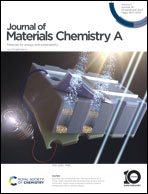Room temperature synthesis and pressure-induced optical properties of lead-free 2D Cs3Bi2I6Cl3 perovskite nanocrystals†
Abstract
Understanding the fundamental properties of two-dimensional (2D) bismuth-based perovskites is essential for their applications in optoelectronic devices. Here, we report the room-temperature synthesis of 2D Cs3Bi2I6Cl3 nanocrystals (NCs) by an anti-solvent assisted crystallization method, which display a broad emission bandwidth with a large Stokes shift primarily originating from exciton self-trapping caused by strong electron–phonon coupling and the critical contribution of Bi–Cl bonds to the band edge is demonstrated. Furthermore, analysis of combined in situ high pressure PL, absorption, Raman and PL decay data indicates that the observed pressure-induced emission (PIE) enhancement can be attributed to the efficient surface reconstruction accompanied by the removal of surface-related trap states, as the interaction between oleic acid (OA) and Cs3Bi2I6Cl3 is strengthened at high pressure. Pressure-induced structural evolutions are well consistent with changes in their optical properties and of particular importance is the retention of 1.5 times PL intensity after releasing pressure. This highlights the importance of steric hindrance and spring effect of the OA ligand in the defect perovskite family, which retain the octahedral distortion in Cs3Bi2I6Cl3 NCs. Our study not only provides deep insights into the structure–property relationship of 2D Cs3Bi2I6Cl3 NCs, but also offers a basis for improving the performance of 2D lead-free perovskite NCs.



 Please wait while we load your content...
Please wait while we load your content...